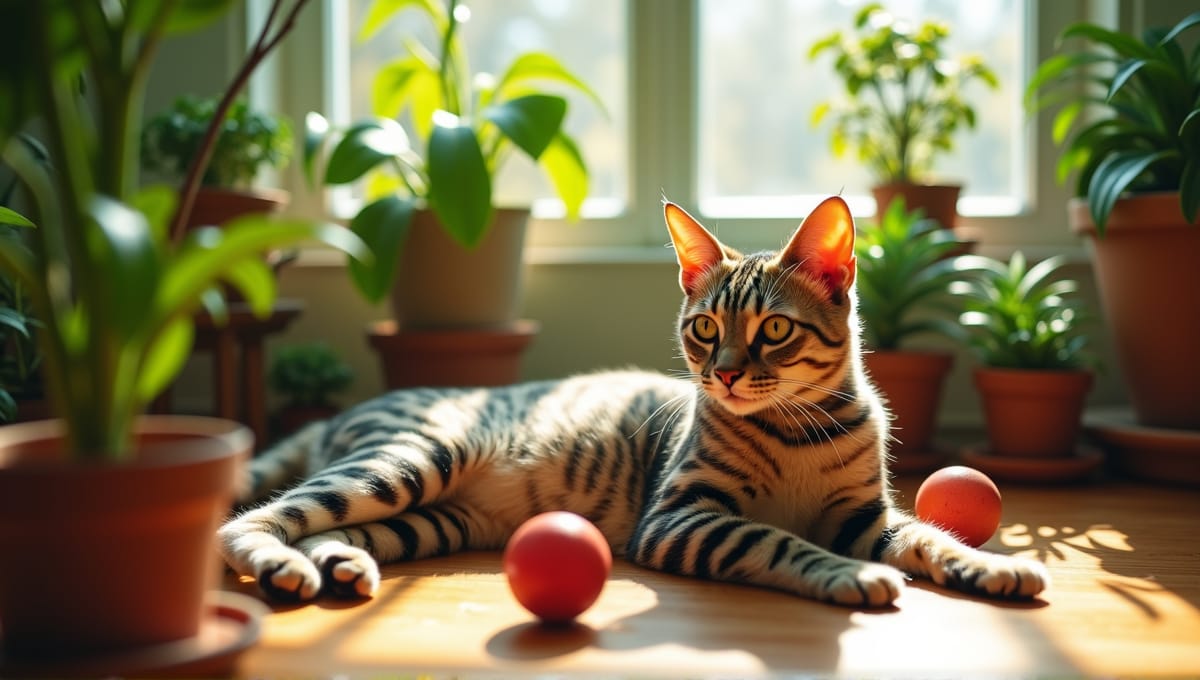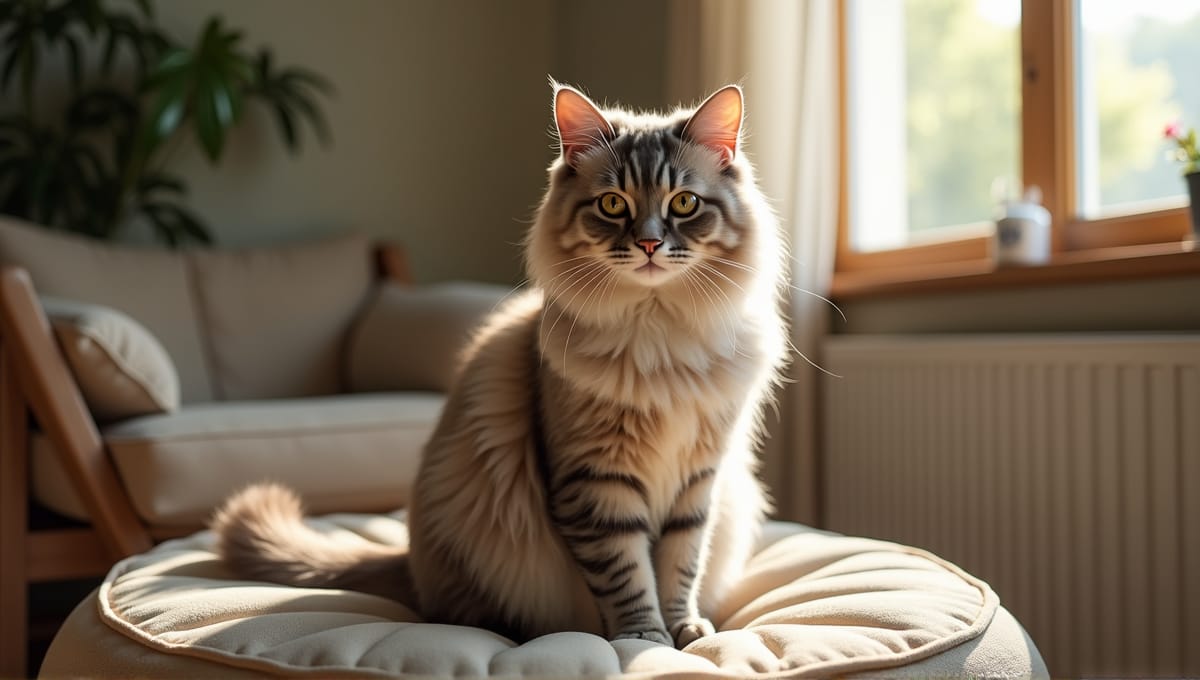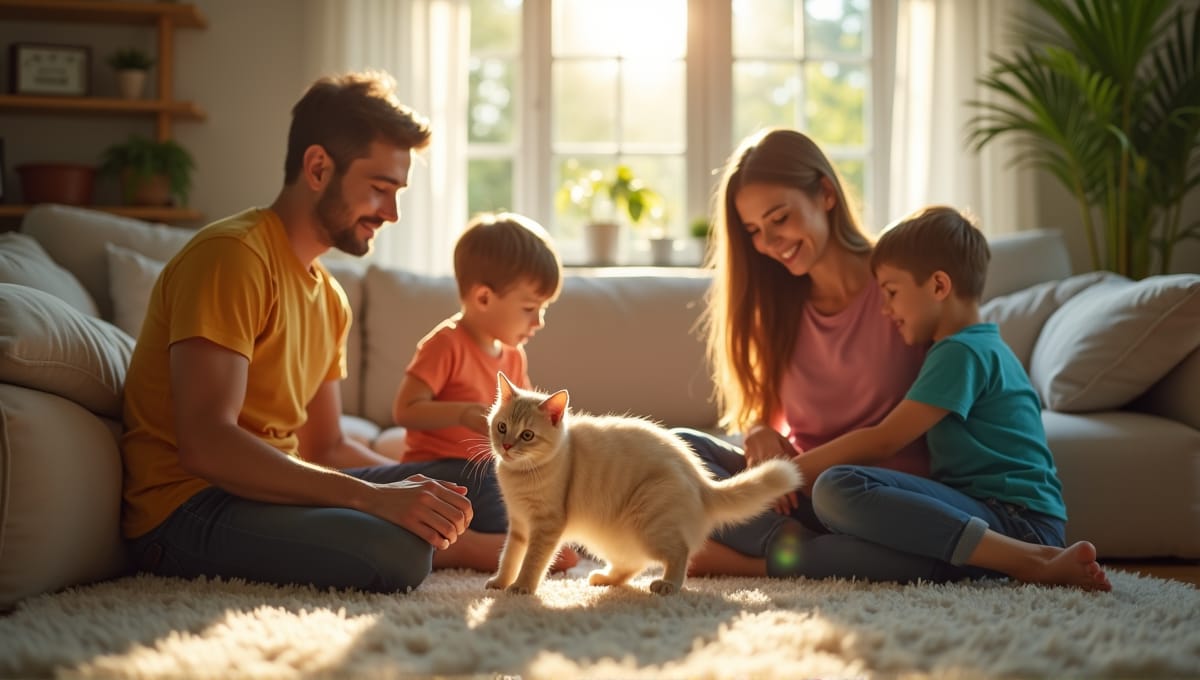As a cat expert, I’ve encountered many muscular cats. These strongmen of the domestic feline world are not only impressive to look at, but they also have some unique care requirements and personalities.
If you’ve seen a muscular cat, you might be wondering if one is right for you. So let’s discuss what makes these cats so unique and how they might be a good fit for you.
Muscular Domestic Cat Breeds

Muscular house cats are truly a sight to behold. These felines are stocky with a powerful presence. There are several breeds of muscular house cats. Here are the most notable ones.
The Maine Coon is the quintessential example of a muscular house cat:
- Largest house cat breed
- Muscular build with long hair
- Can weigh up to 18 pounds
Maine Coons are gentle giants with friendly personalities. I’ve had the pleasure of knowing a few Maine Coons, and they never disappoint.
Norwegian Forest Cats are another breed of muscular house cats. These cats are built to survive Scandinavian winters. And, like the Norwegian Forest Cat, Siberians also have a stocky build designed for cold climates.
Bengal cat brings a bit of the wild to your home. They inherited their muscular build from their wild Asian leopard cat ancestors. Savannah cat breed also fits this category of muscular house cats, as they have both domestic and wild genes.
Other breeds of muscular house cats include the American Bobtail and the Chausie. Each of these breeds has its own unique qualities, but all of them are built like tanks. While these cats are all amazing, many of them require special care due to their stocky build and strength. If you’re interested in exotic cat breeds, these muscular cats might be worth considering.
Structure of Strong House Felines
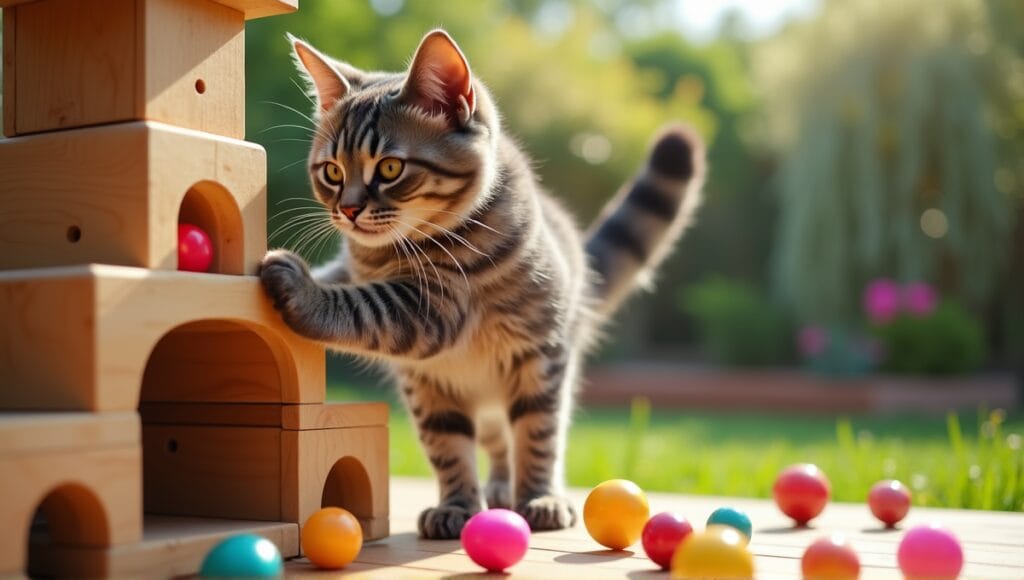
Muscular cats have specific physical characteristics, as their bodies are designed for strength and agility. So let’s take a look at the anatomy of a muscular cat.
A broad chest is a telltale sign of a muscular cat. This is the foundation of their powerful forearms. You can see the biceps on the forearms of a muscular cat. And you can see the strong legs of a muscular cat, allowing it to jump impressively and move quickly.
Solid shoulder development is another sign of a muscular cat. And when you watch a muscular cat move, you can clearly see the shoulder strength it possesses.
Most muscular cats have a boxy body shape:
- When viewed from above
- Indicates muscle mass distribution
This means the muscle mass is distributed evenly throughout the body, as opposed to a triangular shape you might see in a slimmer breed.
A muscular cat has a heavy bone structure to support their muscle mass. When you pick up a muscular cat, you can feel it has a bit more weight to it than a more delicate breed.
All of these anatomical clues make a muscular cat both strong and agile. It’s built for activity, whether that’s hunting, climbing, or just playing. These characteristics are often found in large domestic cats, which are known for their impressive size and strength.
Genetic Factors in Muscular Domestic Cats
Genetics: Genetics are the primary reason a cat has a certain body type. Just as with people, a cat’s genetics play a major role in its physique. How these genetics manifest as muscle mass is something that’s passed down through each generation.
Heredity: Hereditary traits are a cats’ predisposition to build more muscle. This is why certain breeds of cats tend to be more muscular than others.
Most of the muscular cat breeds have traits from a wild cat. This also has implications in how a cat’s body is structured.
- Natural selection and survival: A cat’s body type is often predicated on what helped wild cats survive.
- Environmental factors: A cat may be muscular due to environmental factors, such as cold weathers.
Take the Maine Coon for example. If you ever see one, you’ll notice this breed has a much more muscular structure. This body type likely helped it adapt to the brutally cold winters in New England. The same applies to Norwegian Forest Cats, Siberians, and so on.
Breeding: Breeders have also indirectly impacted why certain breeds are more muscular. For example, breeders may have bred cats together if offspring had a muscular build. This is a common practice in cat breeding, where specific traits are selected and enhanced over generations.
And when caring for many breeds, you can easily tell this is not about what cat food they eat or how much they exercise. Those are the main reasons they are the way they are.
Muscular Domestic Cats vs. Average Cats
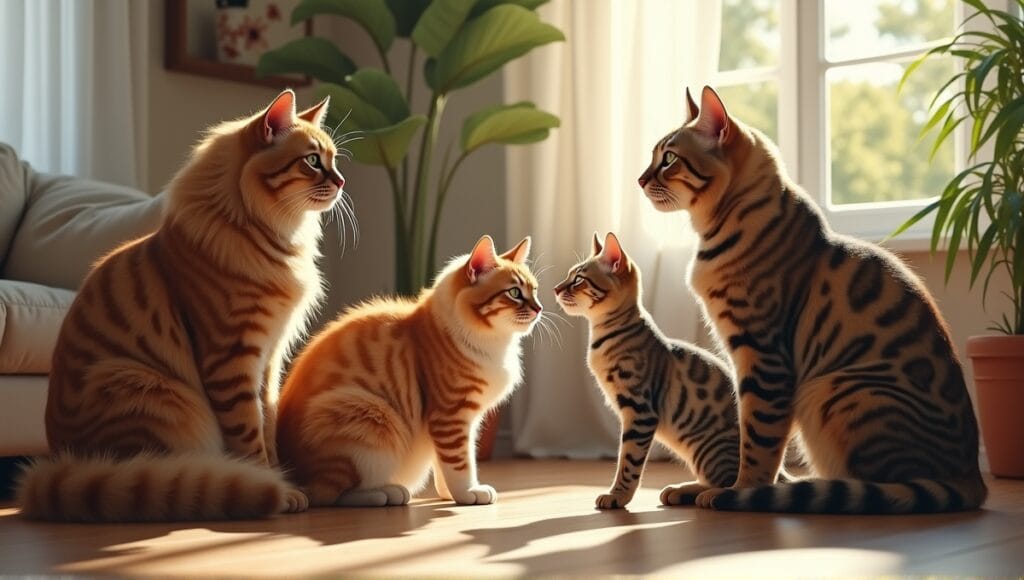
Comparing a muscular cat to an average indoor cat, the most obvious difference is their size and weight.
Weight differences:
- Muscle mass vs. fat
- Average weight range
A muscular cat is heavier due to its muscle mass rather than fat. An average indoor cat might weigh 8-10 pounds. A muscular breed like a Maine Coon can easily weigh 20 pounds.
The body shape is also very different. Muscular cats have a more rectangular body shape. Average indoor cats tend to be more pear-shaped or slender.
Their activity levels are often different as well. Muscular breeds are generally more active than the average indoor cat. They behavior more energetic. I’ve definitely noticed a higher activity level in the muscular cats I’ve cared for.
The strength and agility differences are pretty easy to spot. Muscular breeds can jump higher and play more actively. They are more active pets, which is the behavior you see in them.
These differences impact how you take care of these cats. Muscular breeds often need more food, more space, and more exercise, so understanding these differences is key if you’re thinking of getting a muscular breed. If you’re looking for a less demanding pet, you might want to consider low-maintenance cat breeds instead.
Nutrition Plan for Strong Felines
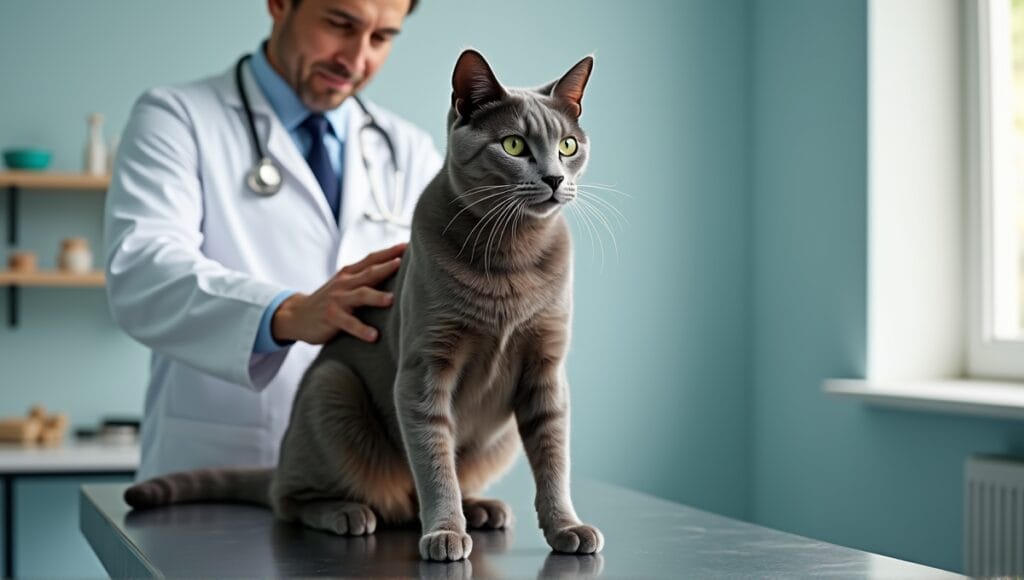
Feeding a muscular cat is slightly different as their diet directly impacts their muscle mass. Therefore, it’s important to ensure they receive the proper nutrients.
High protein diet: Muscular cats require a high protein diet as protein helps maintain muscle mass. If these cats don’t receive enough protein, they will lose muscle mass.
Balanced diet: While protein is key to maintaining muscle mass, it’s also important to ensure they receive all the essential vitamins and minerals.
Here are the best food options:
- Wet food: There are several great wet food options.
- Dry food: Consider a few dry food options.
- Raw food: There are several raw food options.
Wet food often has higher protein content. Dry food is beneficial for dental health. Some owners choose raw food diets, although these require more planning.
Feeding amount: Muscular cats require more food as they need more calories. However, be careful not to overfeed them as this can lead to obesity. I recommend feeding them a set amount of food on a regular feeding schedule.
Supplements: You can also provide supplements to help boost muscle mass. However, check with a vet before beginning any supplement regime as every cat has different needs.
Keep in mind the diet impacts more than just muscle mass. It also influences overall health, energy levels, and lifespan. Therefore, ensure the diet is designed for your cat’s specific needs and lifestyle. This is particularly important for purebred cats, which may have specific dietary requirements.
Exercise Regimen for Muscular Domestic Cats
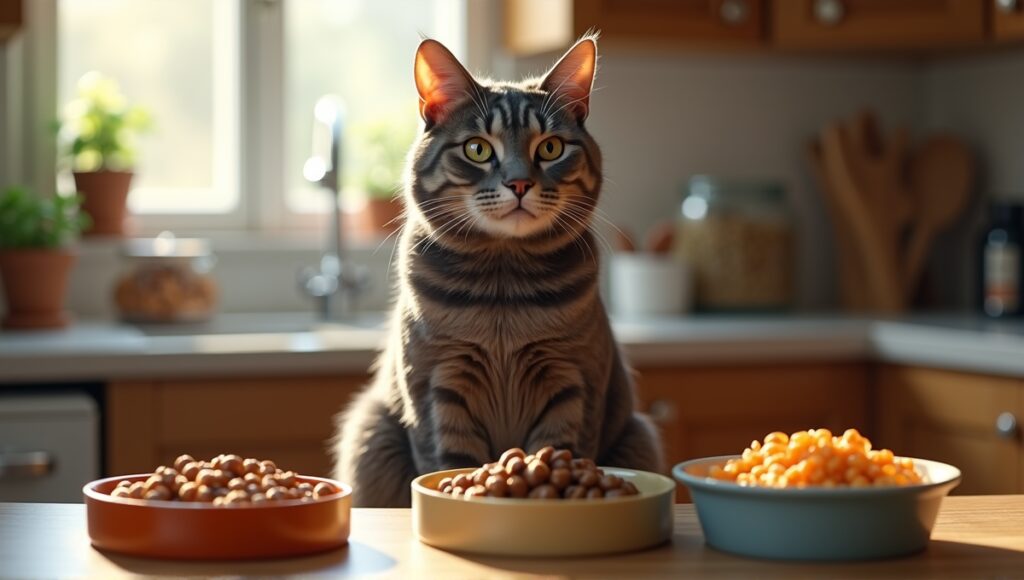
Exercise is essential for strong cats, as it helps them maintain their strength and overall health. Therefore, you should offer them plenty of opportunities for physical activity.
Interactive play sessions are fantastic, as you use toys that prompt them to run, jump, and pounce, which are all excellent natural hunting activities. I’ve personally had success with laser pointers and feather wands.
Climbing and jumping are also important, so be sure to invest in cat trees or wall-mounted shelves. These allow your cat to use its muscles in a vertical space.
If it’s safe, outdoor exploration is a great option. Always monitor outdoor time with your cat. Otherwise, construct a secure catio to give them a taste of the outdoors in a safe environment.
Indoor obstacle courses are a fun and mentally challenging option. Use boxes, tunnels, and platforms to create a diverse landscape, encouraging your cat to try different movements and solve problems.
Regular exercise is also key, so aim to complete several short sessions throughout the day. This keeps your cat engaged and prevents boredom.
However, keep in mind that every cat is different. Therefore, pay attention to the specific activities your cat enjoys most, and then simply adjust your exercise routine to accommodate its favorite activities and capabilities. This is especially important for mixed breed cats, as they may have varying energy levels and exercise needs.
Health Considerations for Muscular Domestic Cats
Muscular cats have some specific health considerations. Their anatomical differences can result in various health issues, so it’s important to be aware of them to ensure you provide the best care.
Joint health is a key concern. The additional weight that comes with muscle can wear on their joints over time. I’ve seen this in older muscular cats. Regular vet check-ups are important to check on joint health.
Regular veterinary check-ups are essential to catch potential issues early. A vet can also monitor a cat’s weight and muscle mass.
Monitoring weight and muscle mass is critical. Any sudden changes could be a sign of an issue. Monitor the cat’s body condition.
Some muscular breeds may have specific genetic health problems. Look into your breed to know of any predisposed health problems. This knowledge allows you to preventively care for it.
Keeping them at a healthy activity level is important. It keeps their muscles strong, and their joints flexible. Yet, as always, the key is balance. Too much or too little activity can cause issues.
Remember that, as a cat ages, it may need special care specific to its muscular build. You may need to adjust its diet or even lifestyle strategy. But with the right care, these beautiful cats can live a long and healthy life. Understanding cat breed intelligence can also help you provide appropriate mental stimulation alongside physical care.
To Conclude
Muscular house cats are intriguing animals. Maine Coons and Bengals, for example, are excellent examples of strong, agile house cats. Their anatomy, genetics, and nutritional requirements differentiate them from the average house cat. Congratulations! You now know everything you need to take excellent care of these strong cats.
Just remember, regular exercise and veterinary exams are the most important things. With the right care, your muscular cat will live a happy, healthy life and continue looking strong for years.




